
Tennis is a sports video game for the Atari VCS which was written by Activision co-founder Alan Miller and published by Activision in 1981.
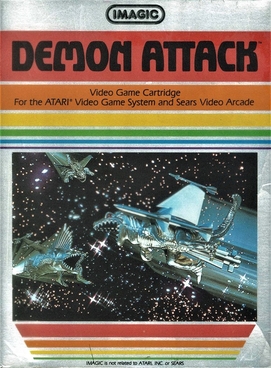
Demon Attack is a fixed shooter written by Rob Fulop for the Atari 2600 and published by Imagic in 1982. It was ported to the Intellivision, Magnavox Odyssey 2, Atari 8-bit family, VIC-20, Commodore 64, Tandy 1000, TRS-80, IBM PCjr, and TRS-80 Color Computer. There is also a port for the TI-99/4A titled Super Demon Attack.
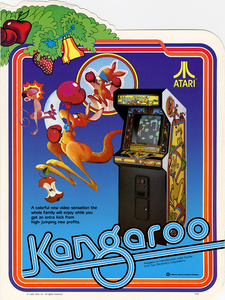
Kangaroo is a four-screen platform game released in arcades in 1982 by Sun Electronics and distributed in North America by Atari, Inc. Kangaroo is one of the first arcade games similar in style to Donkey Kong without being a direct clone. The player takes the role of a boxing glove-wearing mother kangaroo who is trying to rescue her joey from fruit-throwing monkeys.

Venture is a fantasy-themed action game released in arcades in 1981 by Exidy. Each level consists of a playable, overhead map view. Upon entering one of the rooms shown on the map, the game zooms in until the room fills the screen. As a round smiley-face named Winky, the goal is to collect the treasure in each of the rooms. Winky can shoot arrows at enemies which turn into slowly disintegrating corpses when hit. Corpses are still deadly to the touch.

Smurf: Rescue in Gargamel's Castle is a 1982 video game published and developed by Coleco for the ColecoVision and Atari 2600. The game is based on the television series The Smurfs. In the game, the player must brave a series of obstacles to rescue Smurfette from Gargamel's castle.

Electronic Games was the first dedicated video game magazine published in the United States and ran from October 15, 1981 to 1997 under different titles. It was co-founded by Bill Kunkel, Joyce Worley, and Arnie Katz..

Wizard of Wor is an arcade game released in 1980 by Midway. Up to two players fight together in a series of monster-infested mazes, clearing each maze by shooting the creatures. The game was ported to the Atari 8-bit family, Commodore 64, Atari 2600, and Atari 5200 and renamed to The Incredible Wizard for the Bally Astrocade. The original cartridge came with a cash prize offer to the first person to complete the game.
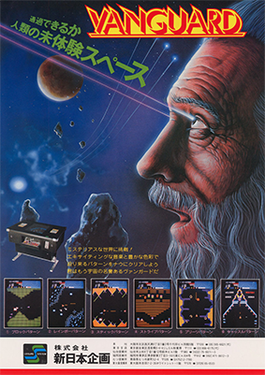
Vanguard is a scrolling shooter arcade video game developed by TOSE. It was released by SNK in Japan and Europe in 1981, and licensed to Centuri for manufacture in North America in October and to Zaccaria in Italy the same year. Cinematronics converted the game to cocktail arcade cabinets in North America. The player flies a ship through forced-scrolling tunnels with sections that move horizontally, vertically, or diagonally, to reach a boss at the end. The ship is controlled with an 8-way joystick, and it can fire in four directions via four buttons in a diamond arrangement.

Megamania is an Atari 2600 game by Steve Cartwright and published by Activision in 1982. Versions were released for the Atari 5200 and Atari 8-bit family in 1983. Megamania is similar to Sega's 1981 arcade title Astro Blaster. Both games have nearly identical patterns of approaching enemies with the player relying on an "energy" meter. The player's ships are remarkably similar in both games.
Bill Kunkel was a graphic novelist as well as pioneering professional wrestling and video game journalist and critic from the 1970s until his death in the early 2010s. During his time working with the video game industry, Kunkel authored numerous strategy guides, co-designed several video games, served as an expert witness in three court cases, and taught courses in Game Design for the University of Nevada, Las Vegas (UNLV). Kunkel served as the executive editor of Electronic Games Magazine and the editor-in-chief of Tips & Tricks magazine, writing columns and comics for several magazines and game sites. He often wrote under nicknames, the most common of which were "The Game Doctor", and "Potshot".
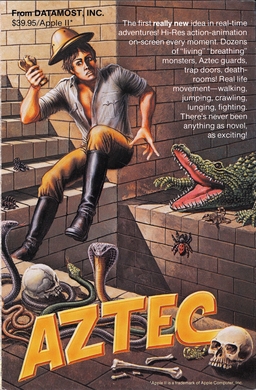
Aztec is an action-adventure game developed by Paul Stephenson for the Apple II and published by Datamost in 1982. It was ported to the Atari 8-bit family and the Commodore 64. In Aztec, the player enters and explores the recently discovered "Tomb of Quetzalcoatl" in Mexico in search of a jade idol.
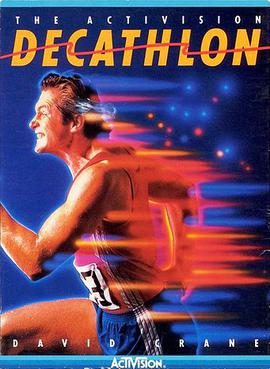
The Activision Decathlon is a sports game written by David Crane for the Atari 2600 and published by Activision in 1983. It was ported to the Atari 8-bit family, Atari 5200, Commodore 64, ColecoVision, and MSX. Up to four players compete in the ten different events of a real-life decathlon, either in sequence or individually.
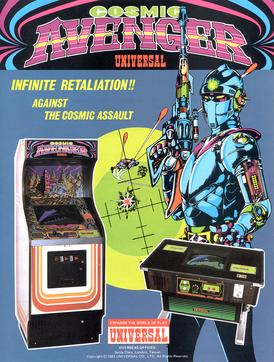
Cosmic Avenger is a horizontally scrolling shooter developed by Universal Entertainment Corporation and released in arcades by Universal in July 1981. It is one of the first shooters with forced X-axis scrolling along with Konami's Scramble released earlier in the year. The final installment in Universal's Cosmic series, players take control of the Avenger space fighter and use bullets and bombs against enemy forces.
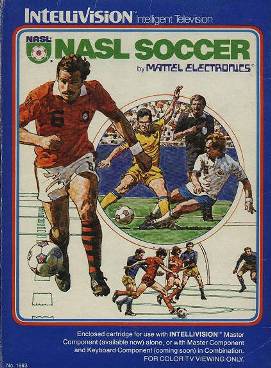
NASL Soccer is a 1980 Intellivision two-player game based on the North American Soccer League (1968–1984). Mattel released an Atari 2600 version of the game under its M Network label as International Soccer.

Space Cavern is a 1982 fixed shooter video game for the Atari 2600 developed and released by Games by Apollo. Players control a spaceship commander who has landed on a planet and must defend the ship against its hostile creatures. Games by Apollo founder Pat Roper was impressed by the game Demon Attack and tasked Apollo member Dan Oliver with making a game very similar to it.
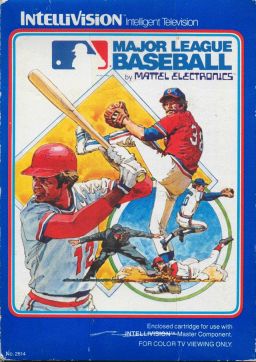
Baseball is a sport video game produced by Mattel and released for the Intellivision home video game console in 1980. As the best-selling game in the console's history, with more than 1 million copies sold, Baseball put players in control of a nine-man baseball team competing in a standard nine-inning game. When first released, Mattel obtained a license from Major League Baseball, although the only trademarked item used is the MLB logo on the box art. No official team names or player names are in the game.
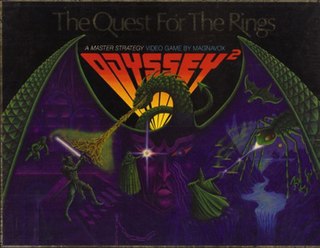
Quest for the Rings is a board game/video game hybrid for the Magnavox Odyssey². It is the first game in the Odyssey² "Master Strategy Series", and contemporary reviews described it as innovative.

Dungeon! is a 1982 video game adaptation of the board game Dungeon!

Axis Assassin is a video game written by John Field for the Apple II and published by Electronic Arts in 1983. Ports for the Atari 8-bit family and Commodore 64 were released alongside the Apple II original. The game is similar in concept and visuals to Atari, Inc.'s 1981 Tempest arcade game.

NFL Football is a sports video game developed by Mattel and released for its Intellivision video game system in 1979. The players each control a football team competing in a standard four-quarter game. Like Mattel's other sports video games, NFL Football did not use any official National Football League team names or player names, even though Mattel obtained a license from the NFL and used the league's logo in its box art. NFL Football has been cited as the first football video game to have a playbook.




















